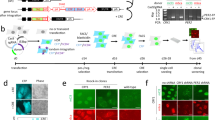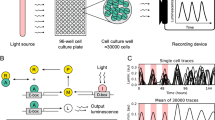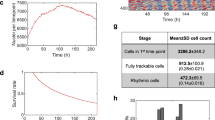Abstract
Zebrafish tissues and cell lines contain circadian clocks that respond directly to light1,2. Using fluorescence-activated cell sorting, we have isolated clonal cell lines that contain the reporter construct, zfperiod4-luciferase3. Bioluminescent assays show that oscillations within cell populations are dampened in constant darkness. However, single-cell imaging reveals that individual cells continue to oscillate, but with widely distributed phases and marked stochastic fluctuations in free-running period. Because these cells are directly light responsive, we can easily follow phase shifts to single light pulses. Here we show that light acts to reset desynchronous cellular oscillations to a common phase, as well as stabilize the subsequent free-running period.
This is a preview of subscription content, access via your institution
Access options
Subscribe to this journal
Receive 12 print issues and online access
$209.00 per year
only $17.42 per issue
Buy this article
- Purchase on Springer Link
- Instant access to full article PDF
Prices may be subject to local taxes which are calculated during checkout


Similar content being viewed by others
References
Whitmore, D., Foulkes, N. S., Strahle, U. & Sassone-Corsi, P. Nature Neurosci. 1, 701–707 (1998).
Whitmore, D., Foulkes, N. S. & Sassone-Corsi, P. Nature 404, 87–91 (2000).
Vallone, D., Gondi, S. B., Whitmore, D. & Foulkes, N. S. Proc. Natl Acad. Sci. USA. 101, 4106–4111 (2004).
Plautz, J. D., Kaneko, M., Hall, J. C. & Kay, S. A. Science 278, 1632–1635 (1997).
Yoo S. H. et al. Proc. Natl Acad. Sci. USA 101, 5339–5346 (2004).
Nagoshi, E. et al. Cell 119, 693–705 (2004).
Welsh, D. K., Yoo, S. H., Liu, A. C., Takahashi, J. S. & Kay, S. A. Curr. Biol. 14, 2289–2295 (2004).
Mihalcescu, I., Hsing, W. & Leibler, S. Nature 430, 81–85 (2004).
Gonze, D., Halloy, J. & Goldbeter, A. Proc. Natl Acad. Sci. USA. 99, 673–698 (2002).
Herzog, E. D., Aton, S. T., Numano, R., Sakaki, Y. & Tei, H. J. Biol. Rhythms 19, 35–46 (2004).
Tamai, T. K., Vardhanabhuti, V., Arthur, S., Foulkes, N. S. & Whitmore, D. J. Neuroendocrinol. 15, 344–349 (2003).
Tamai, T. K., Vardhanabhuti, V., Foulkes, N. S. & Whitmore, D. Curr. Biol. 14, 104–105 (2004).
Acknowledgements
The authors wish to thank N.S. Foulkes for the kind donation of luciferase reporter cell lines and many useful discussions; K. Allen and D. Davies for their expert assistance with cell sorting; M. Pando for help with retroviral techniques; K. Swann for essential input regarding imaging; J. H. Zhao for advice with circular statistics; M. Straume for guidance with FFT-NLLS; and T. K. Tamai for many useful suggestions. This work was supported by funds from The Wellcome Trust and BBSRC.
Author information
Authors and Affiliations
Corresponding author
Ethics declarations
Competing interests
The authors declare no competing financial interests.
Supplementary information
Supplementary Information
Supplementary figures S1, S2 and S3 plus movie legends and supplementary methods (PDF 227 kb)
Rights and permissions
About this article
Cite this article
Carr, AJ., Whitmore, D. Imaging of single light-responsive clock cells reveals fluctuating free-running periods. Nat Cell Biol 7, 319–321 (2005). https://doi.org/10.1038/ncb1232
Received:
Accepted:
Published:
Issue Date:
DOI: https://doi.org/10.1038/ncb1232
This article is cited by
-
A stochastic oscillator model simulates the entrainment of vertebrate cellular clocks by light
Scientific Reports (2021)
-
The clock components Period2, Cryptochrome1a, and Cryptochrome2a function in establishing light-dependent behavioral rhythms and/or total activity levels in zebrafish
Scientific Reports (2019)
-
Light- and circadian-controlled genes respond to a broad light spectrum in Puffer Fish-derived Fugu eye cells
Scientific Reports (2017)
-
Life in a dark biosphere: a review of circadian physiology in “arrhythmic” environments
Journal of Comparative Physiology B (2016)
-
In vitro and ex vivo models indicate that the molecular clock in fast skeletal muscle of Atlantic cod is not autonomous
Molecular Biology Reports (2014)



